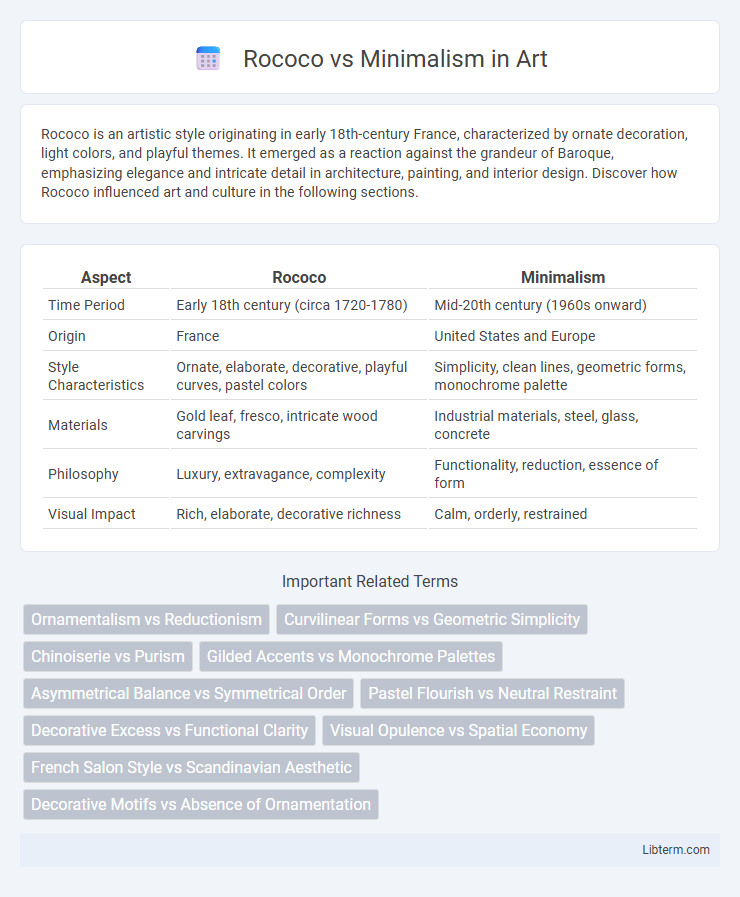Rococo is an artistic style originating in early 18th-century France, characterized by ornate decoration, light colors, and playful themes. It emerged as a reaction against the grandeur of Baroque, emphasizing elegance and intricate detail in architecture, painting, and interior design. Discover how Rococo influenced art and culture in the following sections.
Table of Comparison
| Aspect | Rococo | Minimalism |
|---|---|---|
| Time Period | Early 18th century (circa 1720-1780) | Mid-20th century (1960s onward) |
| Origin | France | United States and Europe |
| Style Characteristics | Ornate, elaborate, decorative, playful curves, pastel colors | Simplicity, clean lines, geometric forms, monochrome palette |
| Materials | Gold leaf, fresco, intricate wood carvings | Industrial materials, steel, glass, concrete |
| Philosophy | Luxury, extravagance, complexity | Functionality, reduction, essence of form |
| Visual Impact | Rich, elaborate, decorative richness | Calm, orderly, restrained |
Introduction to Rococo and Minimalism
Rococo, originating in early 18th-century France, is characterized by elaborate ornamentation, intricate detailing, and a playful use of curves and pastel colors, reflecting luxury and exuberance. Minimalism, emerging in the mid-20th century, emphasizes simplicity, clean lines, and a restrained color palette to create functional and clutter-free spaces. Both styles represent contrasting artistic responses to their cultural contexts: Rococo embodies decorative opulence, while Minimalism pursues modernist clarity and efficiency.
Historical Background of Rococo
Emerging in early 18th-century France during the reign of Louis XV, Rococo art and design epitomized the ornate and decorative style characterized by intricate details, asymmetrical patterns, and pastel color palettes. This artistic movement reflected the aristocratic tastes of the time, emphasizing elegance, lightness, and playful themes inspired by nature and mythology. Rococo's historical prominence contributed to its contrast with later minimalist ideals, which favored simplicity and functionalism over elaborate ornamentation.
Origins and Growth of Minimalism
Minimalism emerged in the late 1950s as a reaction against the ornate and elaborate Rococo style, emphasizing simplicity, clean lines, and functionality. Originating in post-war America, Minimalism was heavily influenced by artists like Donald Judd and architects such as Ludwig Mies van der Rohe, who promoted the "less is more" philosophy. The movement grew rapidly throughout the 1960s and 1970s, shaping modern design, art, and architecture with its focus on reductive forms and the elimination of unnecessary decoration.
Key Aesthetic Principles: Rococo
Rococo is characterized by elaborate ornamentation, intricate details, and a playful use of curves and asymmetry, emphasizing elegance and lightness. Its aesthetic principles include pastel colors, gilded accents, floral motifs, and a sense of movement that evokes joy and opulence. This style contrasts sharply with minimalism's focus on simplicity, clean lines, and functional forms.
Key Aesthetic Principles: Minimalism
Minimalism emphasizes simplicity, clean lines, and a monochromatic color palette, prioritizing functionality and space over ornate details. It strips design elements to their essential components, using open spaces to create a sense of calm and clarity. The aesthetic rejects excess decoration, favoring geometric shapes and natural materials to enhance visual harmony and practical living.
Color Palette and Material Comparison
Rococo design features a vibrant and pastel color palette, including shades of gold, pink, mint green, and light blue, often combined with rich textures such as gilded wood, carved marble, and silk brocade. In contrast, Minimalism employs a neutral color scheme dominated by whites, blacks, grays, and earth tones, utilizing materials like stainless steel, glass, concrete, and raw wood to emphasize simplicity and functionality. The lavish, ornamental materials and soft hues of Rococo contrast sharply with the clean lines and subdued, natural finishes that define Minimalist interiors.
Furniture and Decorative Features
Rococo furniture is characterized by intricate carvings, ornate curves, and elaborate gilded details that emphasize luxury and artistic expression, often featuring motifs like shells and floral patterns. Minimalism emphasizes simplicity, with furniture designed to be functional and sleek, typically using neutral colors, clean lines, and unadorned surfaces to create an uncluttered, spacious environment. Decorative features in Rococo interiors include elaborate mirrors, crystal chandeliers, and richly textured fabrics, whereas Minimalism favors bare walls, subtle textures, and minimal accents to enhance light and space.
Impact on Modern Interior Design
Rococo's intricate ornamentation and lavish detailing contrast sharply with Minimalism's emphasis on simplicity and functionality, shaping modern interior design by highlighting two opposing aesthetics. Rococo influences modern interiors through luxurious textures, elaborate patterns, and decorative furnishings that create an opulent atmosphere. Minimalism impacts contemporary spaces by promoting clean lines, open layouts, and neutral color palettes, fostering a sense of calm and uncluttered environments.
Cultural Significance and Influences
Rococo's ornate and elaborate designs reflect the 18th-century European aristocracy's emphasis on luxury, leisure, and artistic expression, symbolizing social status and cultural opulence. In contrast, Minimalism centers on simplicity and functionality, emerging in the mid-20th century as a reaction against consumerism and excess, influenced by Zen philosophy and modernist principles. These styles culturally embody divergent values: Rococo celebrates decorative complexity and historical grandeur, while Minimalism champions clarity, efficiency, and mindfulness.
Rococo vs Minimalism: Which Suits Your Style?
Rococo and Minimalism represent two contrasting interior design styles, with Rococo characterized by elaborate ornamentation, intricate patterns, and rich colors, while Minimalism emphasizes simplicity, clean lines, and neutral tones. Choosing between Rococo and Minimalism depends on whether you prefer the opulence and detailed aesthetics of 18th-century French artistry or the modern, functional approach that focuses on space and light. Your personal style, space functionality, and desired atmosphere play key roles in determining whether Rococo's decorative extravagance or Minimalism's understated elegance suits your home.
Rococo Infographic

 libterm.com
libterm.com